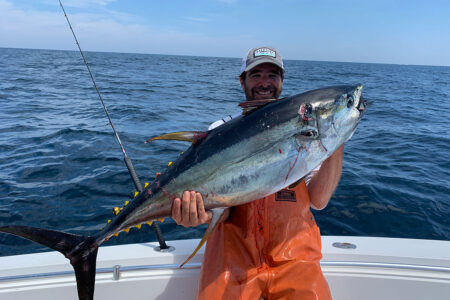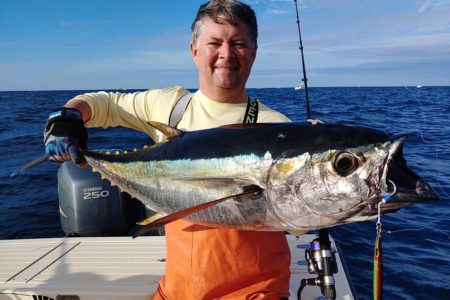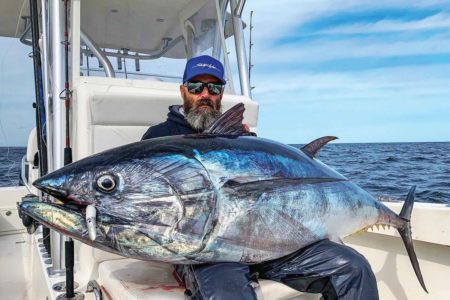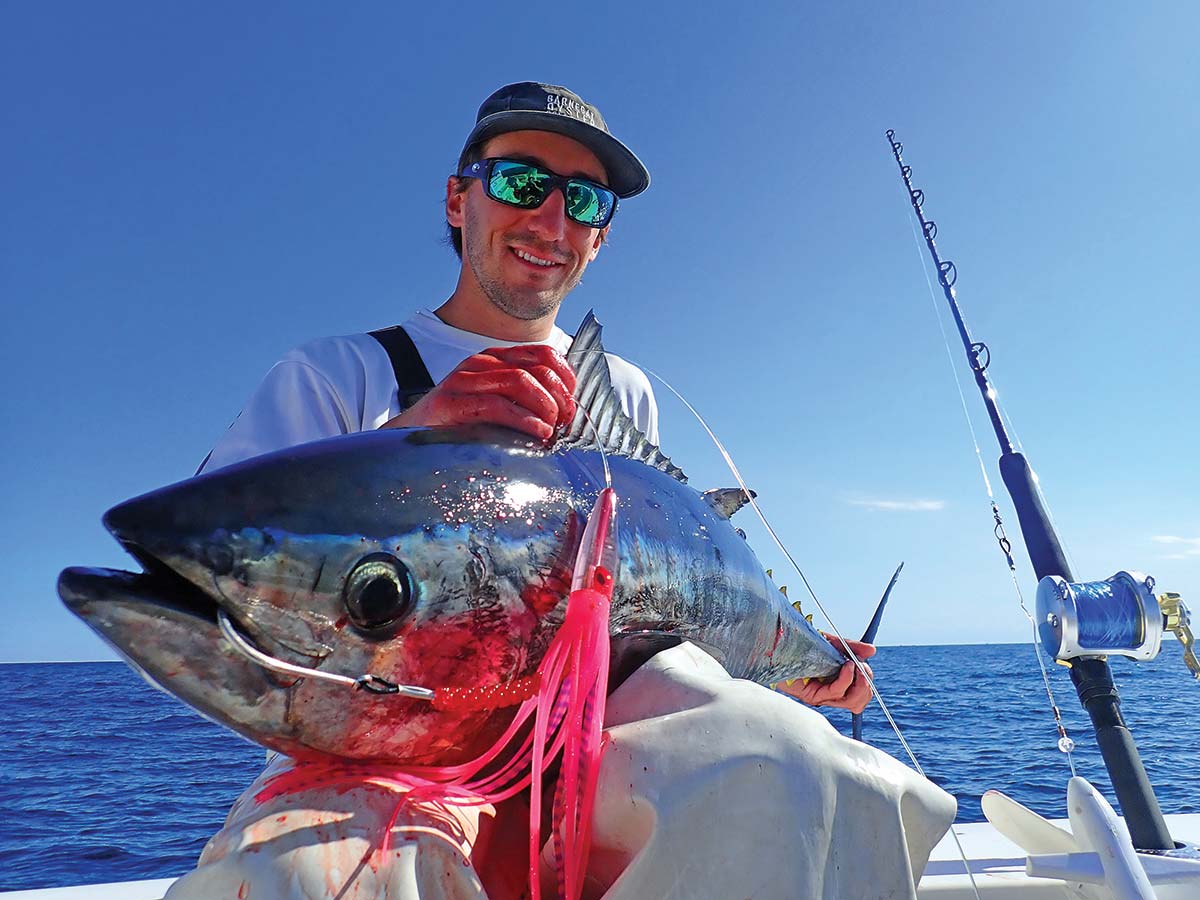
“When everybody works together, more tuna get caught.”
It’s almost overwhelming. You get to the tuna grounds and witness hundreds of acres of whitewater of bluefin and yellowfin are crashing bait schools up on the surface right in between breaching humpback whales and common porpoise schools. The sheer amount of marine life in its dynamic natural act is enough to make you stare in awe. But there are tuna to be caught. Where do you start? What do you do?
Obviously, when you see bombing schools of the Thunnus family, you go bonkers, immediately whipping out everything you’ve got rigged and ready. But in your frenzy, take the time to assess the situation first. How are the tuna feeding? Are they finning the surface or blowing up? Or are you visually seeing them below the surface cruising?
Also, if whales and/or porpoises are feeding, notice if they are corralling the bait into a pod or where the tuna are in respect to the pod (learn more about how to interpret whale behavior in the July edition of The Fisherman). Many times the tuna are behind the big marine mammals to gobble down injured baitfish.
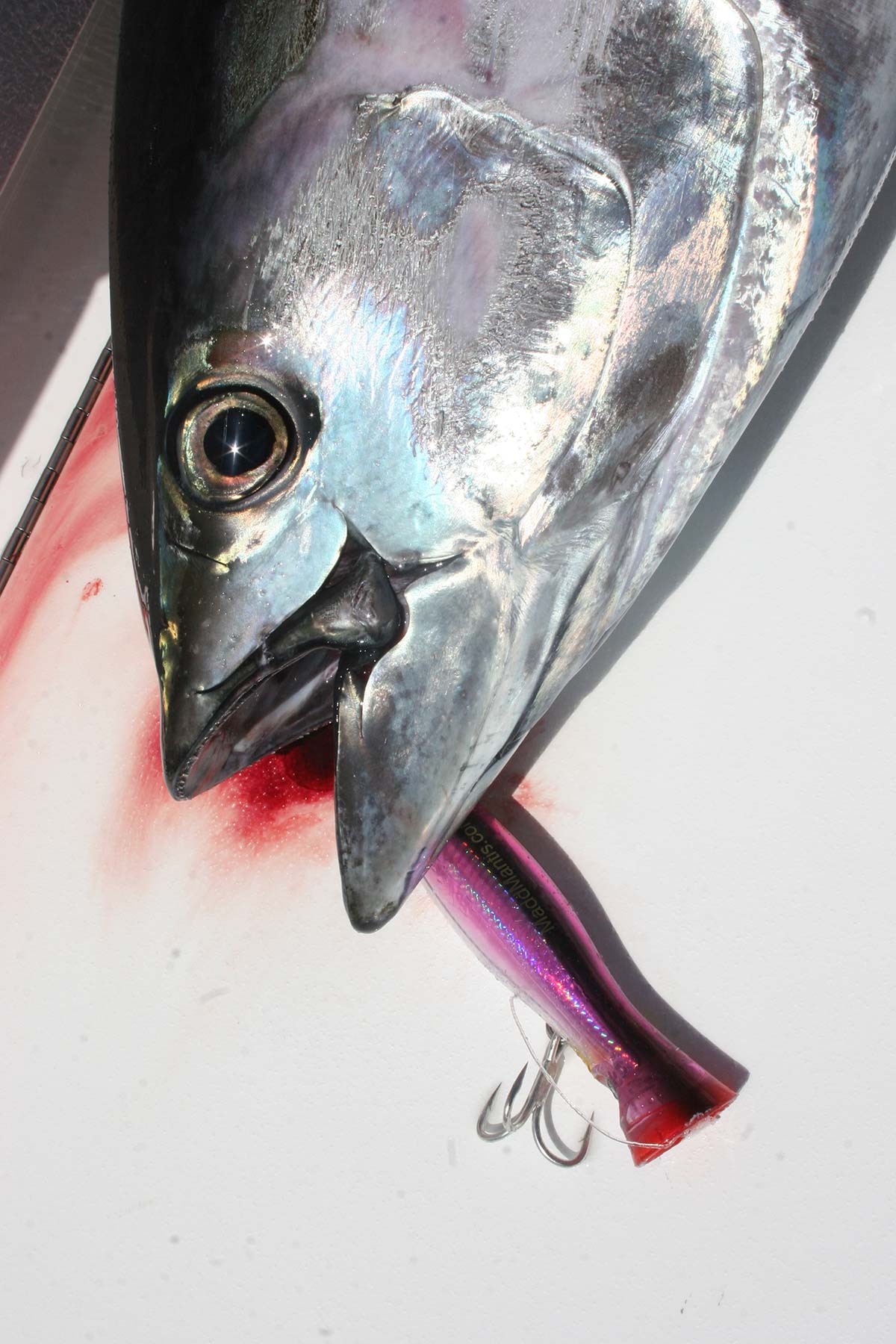
Access The Situation
If you’re lucky enough to come upon feeding tuna first on the scene, don’t blow it by revving the engines and quickly running and gunning to them; that will only push them down. It’s the time to keep your cool. Take the throttle down into neutral and watch what is happening. So many times captains keep running engines blaring soundwaves underwater and scaring the schools pushing them down.
A great rule of thumb is to anticipate where the tuna are heading, then get way in front of the school about 400 yards and let them come to you. Your patience will pay off to observe how in fact they are feeding and that’s the start to success. Don’t blow your chance by being impatient and noisy. As well, it’s important to try and notice the size, shape and species of the bait the tuna are feeding on. That will help you match the hatch and lure retrieve to the best of your ability to mimic the natural action.
When tuna are crashing the surface, start with your crew of anglers casting big topwater chugging poppers like the Madd Mantis, Yo-Zuri Bull Popper and Island X Hellfire. Have guys pinpoint different areas of the schools and cast on the outskirts of the whitewater and work the popper back in long sweeping strokes. Most times the tuna will hit when you pause for a second to let the popper sit for a second between sweeps. If you find that sweet spot where a tuna hits one angler’s popper, immediately have the other guys cast to the same area as the tuna are all dialed in to that targeted feed in that particular spot.
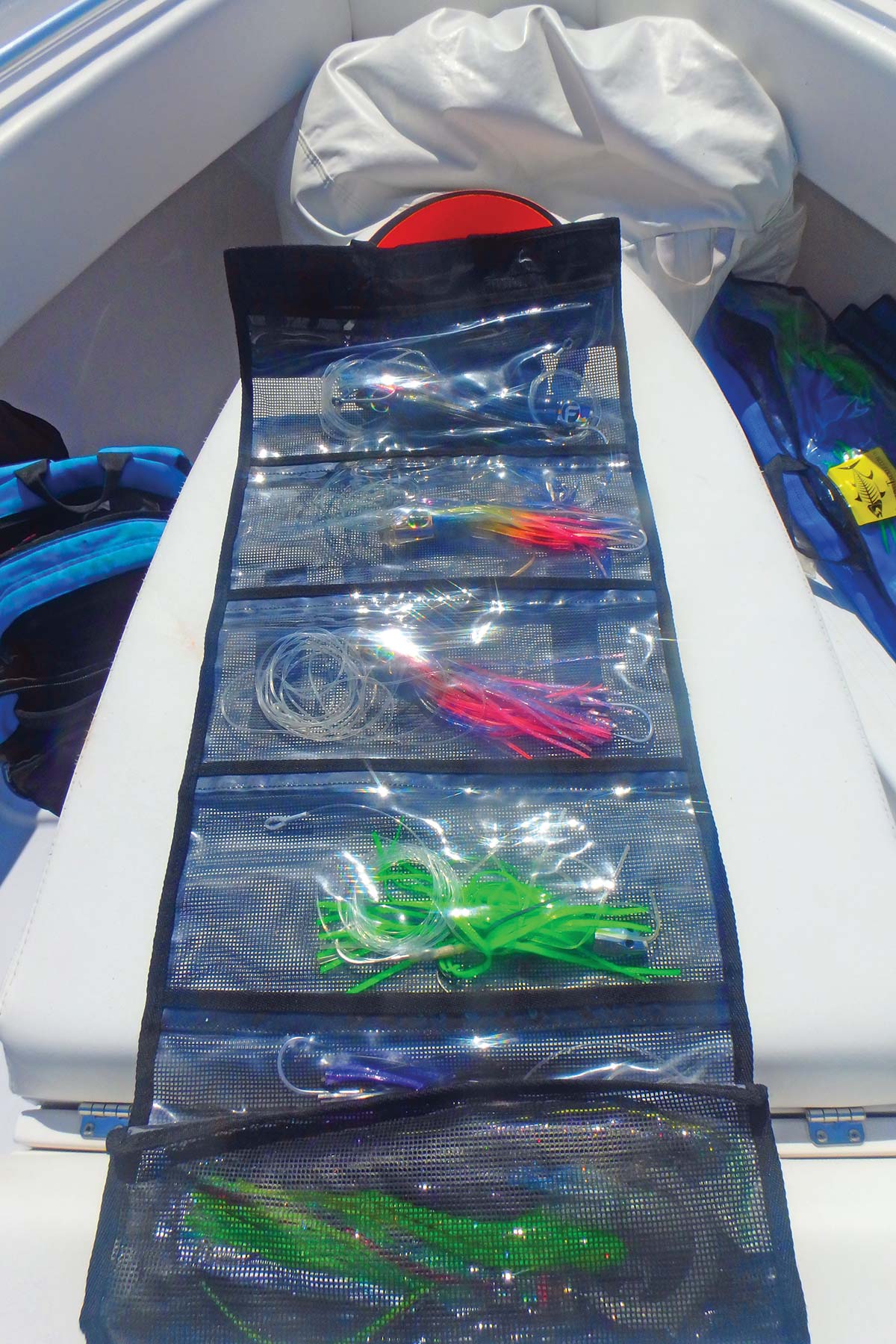
If poppers don’t get the reaction strike either casting outside of the school or directly into it, then switch up to a stickbait/slidebait such as the Savage Gear Mack Stick, Williamson Popper Pro or Island X Sidewinder. The slidebaits present themselves like a lost and/or injured baitfish that got removed from the bait school, giving tuna a dead eye, lonely and lost target to hit. Stickbaits can be worked in various ways, but to start, cast out and let it sink for a f5 to 10 count, then engage the reel and start by long swooping pulls, followed by a second or two of a pause, then repeat. Tuna will follow the lure sometimes all the way to the boat. If they are following yet don’t hit, change the retrieve by either implemented a quicker “walk the dog” style of retrieve or by frantically giving quick short pulls to elicit a strike.
The next step when drifting around the tuna is to watch the fishfinder. See where the fish are marking if they pass under the boat. If they’re marking down deeper than 30 feet, switch up to metal butterfly type jigs or soft baits such as Shimano Butterfly jigs in 100- to 200-gram sizes, or RonZ 5- to 10-inch soft baits, as well as the Hogy Harness jigs. Metals like butterfly jigs can be dropped down then speed reel/snapped back up the water column. Soft baits can be raised and lowered while maintaining a steady reel back to the boat.
Adapt, Improvise, Overcome
If the action for casting/jigging lures simply isn’t there, there’s always the option to motor around a school at a 5- to 8-knot pace and drag spreader bars like Sterline wide trackers, the Chatter Lures sidetrackers and Ilander lures rigged with ballyhoo and cedar plugs. Trolling by far is the easiest way to find where tuna are if they don’t show themselves. A general spread would consist of six spreaders out in a “W” type pattern, then putting two rigged ballyhoos off the outriggers and two cedar plugs in close off the first wake I the prop wash. (Check out Capt. John Raguso’s article on perfecting your tuna spread in the June edition of The Fisherman)
If you are marking fish, stay in the area keeping a figure-eight pattern over a couple hundred yards back and forth. If nothing is marking, the troll will raise and find fish where you can pull the throttles back and start to jig/pop or cast stickbaits out to possibly start your own blitzing conditions and raise the school to the surface to cast to.
Unless you’ve lucked out, chances are there’s going to be a big fleet of boats working the grounds. It’s always the low hanging fruit to jump right in the middle of the fleet, but my modus operandi to stay away from the middle of the fleet and to work the outskirts of any fleet as tuna are moving way quicker than you think.
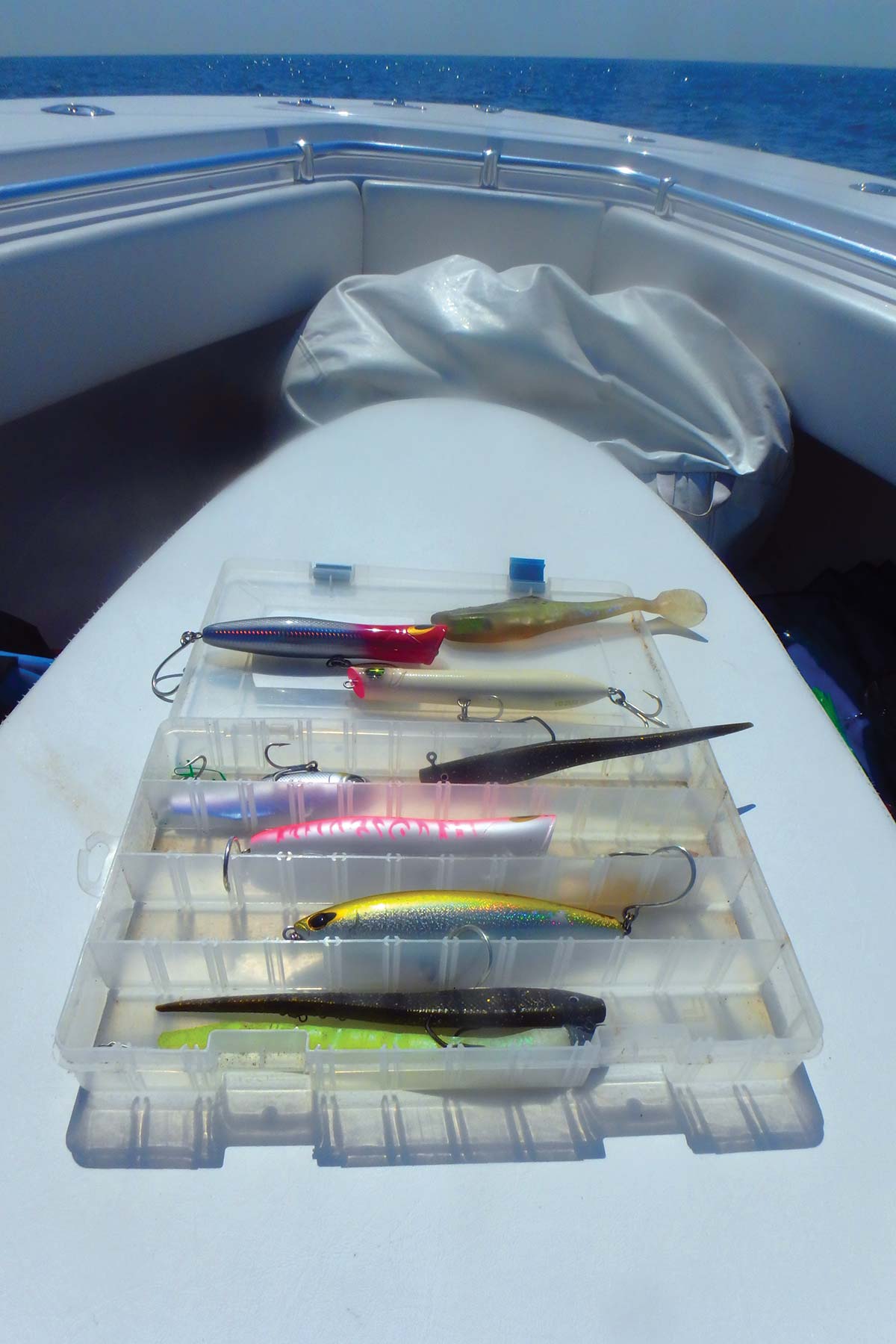
Minding your spread among the fleet can be a daunting task and you have to constantly aware of your approach with zillions of boats around, so it’s best off to peel off just outside of the fleet to start your own bite. The radio may be full of expletives and jawing of guys cutting spreads, scaring a school and what not, so it’s best not to even engage in that behavior just because your adrenaline gets the best of you. When everybody works together, more tuna get caught. Quietness outside of the mayhem will attract tuna.
No matter how it all unfolds when you get to the tuna grounds, pre-trip mental preparation is the key to success even before you leave the dock. Have a solid gameplan together before you get out there and that means understanding among the crew who is on the rod, who is the gaff man, whos taking photos, and who is running the boat. Have the lineup of duties described and understood, otherwise all out chaos and sometimes even dangerous happenings can occur if everybody is running around frantic not knowing what they’re supposed to do.
When you line it all up, taking the chance out of it and capitalizing on the luck, a day out working the tuna schools can be not only enjoyable, but downright create legendary memories burned into your brain that last a lifetime.
| REGISTER & REPORT |
| In order to recreationally fish for and retain Atlantic highly migratory species, vessel owners to purchase the $26 Highly Migratory Species (HMS) angling permit, which can be done online at hmspermits.noaa.gov. Remember that if you hold either an HMS Angling Permit or HMS Charter/Headboat Permit, you must report *bluefin tuna landings and dead discards, and swordfish and billfish landings within 24 hours of returning from a trip.
Tuna Min. Size (Curved Fork) Bag Albacore/Longfin None No Limit Bigeye 27 inches No Limit Skipjack None No Limit Yellowfin 27 Inches Three Per Person *Effective May 3, 2023 through December 31, the bluefin tuna retention limit for HMS Angling-permitted vessels is two fish from 27 to 47 inches, and one large school/small medium bluefin from 47 to less than 73 inches. For charter boats with HMS Charter/Headboat category permits, when fishing recreationally it’s three school bluefin and one large school/small medium bluefin. For head boats with HMS Charter/Headboat category permits, when fishing recreationally it’s six school bluefin and two large school/small medium bluefin. As per HMS rules these limits along the East Coast are per vessel per day/trip. Because bluefin limits (trophy fish) change often, visit the HMS Permit news page for updated information at hmspermits.noaa.gov/news. |
